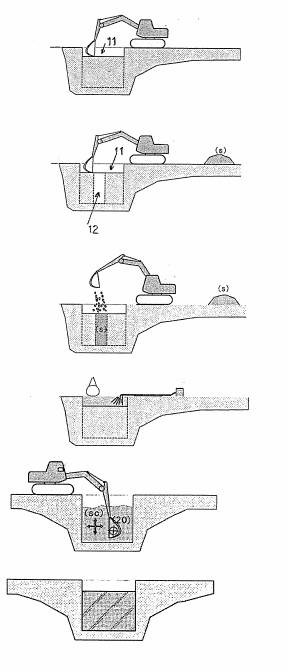CLAIM ELEMENT CONSTRUED NARROWLY USING DESCRIPTINS OF SPECIFICATION
On July 24, the Intellectual Property High Court upheld a district court decision that the accused method did not infringe a patent JP 2783525 B directed to a method for improving and stabilizing grounds for buildings or structures.
CLAIM AT ISSUE
Claim 1 at issue of the patent reads as follows:
1. A method for improving and stabilizing grounds, comprising the steps of
(A) excavating soils at a site where a foundation of a structure will be built to form a cavity (2) having a certain opening area and a certain depth; (Figure 1)
(B) filling the excavated soils (S), solidification agent such as cement (C) and water (W) in certain proportions into the cavity (2) while an amount of water (W) is adjusted according to a water content of the soils (S); (Figure 2)
(C) mixing and stirring the soils, the solidification agent and the water within the cavity (2) to generate a mixed slurry (SC) with a controlled water content ratio; and (Figure 2)
(D) solidifying the mixed slurry (SC). (Figure 3)

ACCUSED METHOD
Accused method has following steps S(a)-S(d).

S(a):Cavity Formation
Excavating soils at a site where a foundation of a structure will be built to form a cavity (11) having a certain opening area and a certain depth.
S(a1): Vertical Hole Formation
Further excavating soils partially below the cavity (11) to form groove(s) or vertical hole(s) (12) reaching a support layer in order to verify an existence of the support layer.
S(a2): Backfill
Backfilling the groove(s) or hole(s) (12) with the excavated soils.
S(b):Fill
Filling the cavity (11) with solidifying agent and water while controlling an amount of the water.
S(c):Mix
By using a basket of mixing and stirring machine, mixing, but not excavating, soils with the solidifying agent and water to generate a slurry within the opening area.
S(d): Solidify
Solidifying the slurry to complete an improved and stabilized ground.
LITERAL INFRIGEMENT
The claim construction question is the meaning of the term “cavity”. The court said that the cavity 11 of the accused method does not correspond to the cavity of the invention because (i) although the cavity is described in the specification of this patent as it reaches the support layer, the cavity 11 formed at step S(a) of the accused method does not reach the supporting layer, and (ii) the soils under the cavity 11 are not discharged or removed therefrom , so that the accused method lacks the claimed element (A).
DOCTRINE OF EQUIVALENTS
The court said that the accused method does not infringe the claim under the doctrine of equivalents because steps S(a1), S(a2) are to form grooves or vertical holes reaching the support layer and, after verifying the existence of the support layer, the grooves or holes are back-filled with the excavated soils, which means that a series of process including mixing, generating slurry and solidifying steps would not be done within the cavity.
http://www.courts.go.jp/hanrei/pdf/20120703114851.pdf